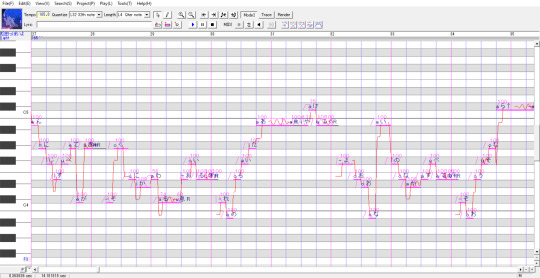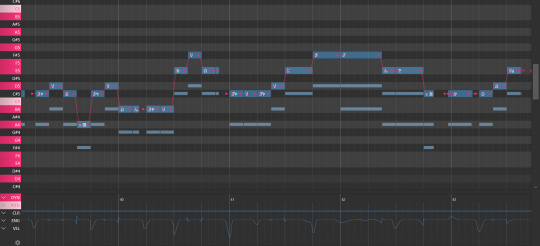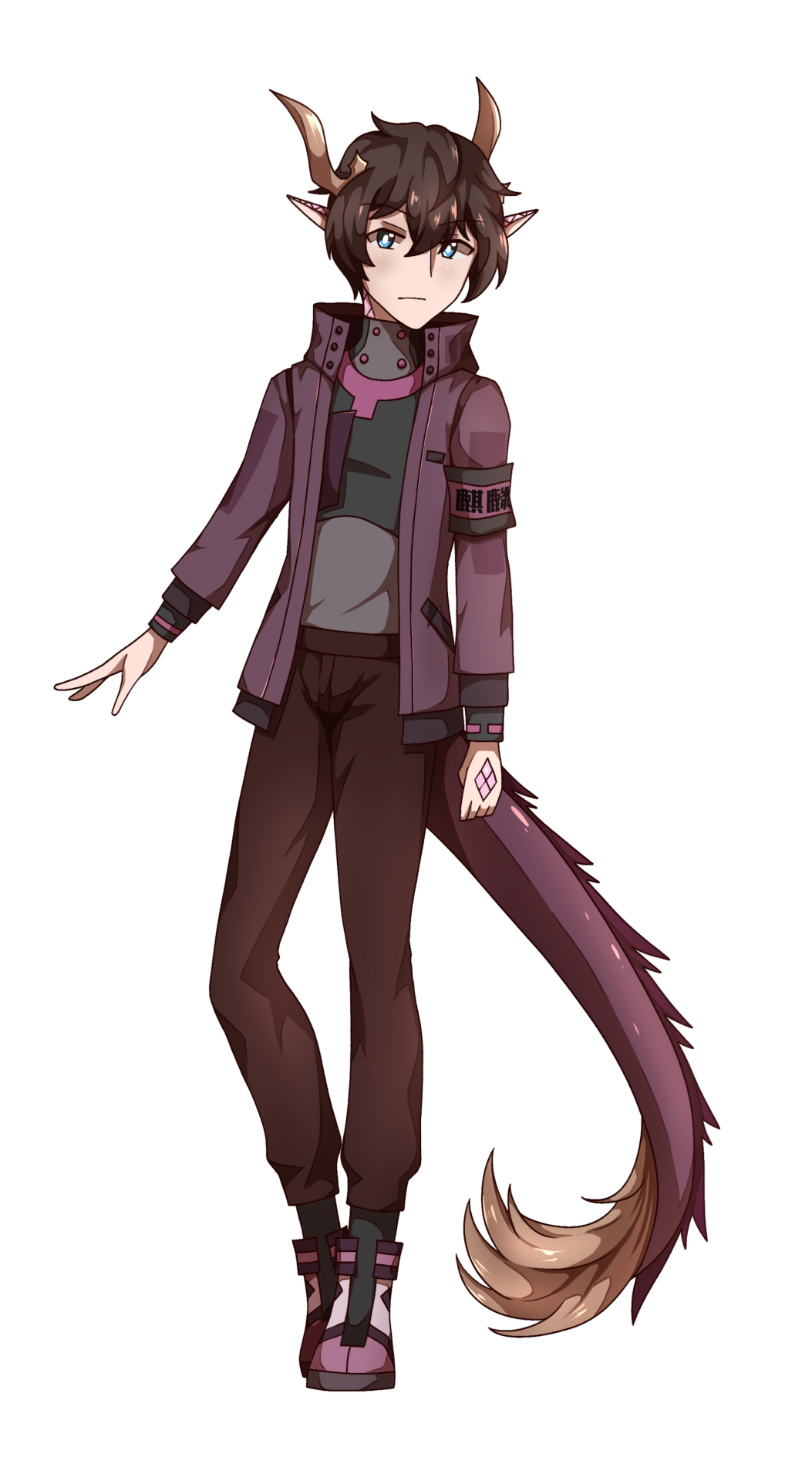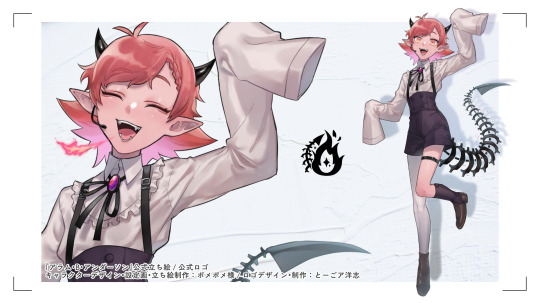#VCV Multipitch
Explore tagged Tumblr posts
Text
OpenUtau and random tutorials saves my life you have NOOOOOOOOOOO idea
#i was re-recording Schafs VCV voicebank (making a multipitch) and finished it up a while ago#being able to autoset the setting so i don't have to manually add the prefixes AND convert to VCV from CV ???#THIS MAKES MAKING USTS AND PLUGGING IN USTS SO MUCH EASIER AAAAAAAAAAAA#ALSO RECORDING ON A CONSTANT 140 BPM AND CORRECT PITCH IS SENDING ME TO THE MOON#ARGHHHHHHHHHHHHHHH IM HAPPY#ehn txt
3 notes
·
View notes
Text

Momone Momo! Voiced and Managed by Momoko Fujimoto (藤本萌々子)
The third bank ever created for UTAU! Momo originally released May 22nd, 2008, and currently she's most well known for being the "voice" of Nyan Cat!
She's a maid android built to be a house keeper and nanny, she also has the ability to sing. She's a very genuine and obedient person, but also very sensitive and will stutter when she's nervous. She's incredibly fast and proficient, and can exert super human strength for short bursts when need be. She also has like, an entire extended family, none of which seem to have voice banks to them, except her older brother Momotaro, but his bank is only on UTAU synth, the UTAU for mac, so I can't use him OTL
Momo is also part of one of the most well known cases of UTAU lost media! She's missing a CV bank with Many recorded pitches, and an entire collection of breath samples. Her missing multipitch CV bank was even a precursor to the VCV standard.
Do not take my word as Gospel! If I got anything wrong feel free to correct me!
70 notes
·
View notes
Text
Preliminary Considerations - Which Vocal Synthesizer Software is Right for You? - Free Softwares
Although this blog puts a major emphasis on the VOCALOID 4 editor, it, or VOCALOID in general, is not the only vocal synthesizer that exists. There are tons of other software that have the same function and a variety of different voicebanks, with some being cheaper and of higher quality than VOCALOID, or even free! That’s right, there are quite a few free vocal synthesizers out there (however the lack of frills may come at the expense of some missing features or difficulty of usage), which I recommend trying out before pouring your hard-earned savings on a program that you may not even use. What if you learn that you do not enjoy tuning or do not have the time to use the software? It would be a huge waste of money that could be invested in other stuff, such as basic necessities (GOOD FOOD) or other leisurely items, like video games, clothing from your favourite bands, art supplies, or merchandise. In addition, there has been a rise of a lot of smaller companies coming out with vocal synthesizers with incredible UIs that not only look appealing but are easy to navigate, and voicebanks that sound far too human and advanced than hATsUnE mIKU (don’t worry, I love Miku with all my heart, I am just trying to prove a point here). There are also some really sick features that you may not find in the franchises with bigger names.
In this post, I will be describing the features of different free vocal synthesizers and their advantages and disadvantages so you can find the one that meets your vocalo-p needs. Please note, I do not own all of these synthesizers, some of these are from reviews on Reddit and VocaVerse Network. In addition, some cons like lag could just be a me problem and better computers may not experience such issues. Also , I will not be covering every single singing synthesizer in existence, just the well known ones and those with proper UIs because there are so many. I am omitting NEUTRINO because it does not have a UI despite having such high-quality vocals, along with ALTER/EGO, as it does not have a piano roll.
UTAU

(Song: Meltdown by iroha(sasaki); UST: Tanjiro Taidana)
UTAU was designed to be the free sister software to VOCALOID. Not only can you use it without spending a cent, but it allows you to make your own voicebank as well! There are tons of popular voicebanks out there, including the Vipperloids, Gahata Meiji, Kohaku Merry, Matsudappoiyo, Denatsu Sora, Shuu Mawaine, and my personal favourite, SUZU.
Pros:
Almost every single voicebank is free to download
Different types of voicebanks (CV, VCV, CCVC; Monopitch vs. Multipitch; Power, Weak, Soft, Whisper, Growl, Screamo; tons of languages)
Can make your own voicebank right in the software
Pitch bending on the piano roll instead of a parameter box!
Variety of job plugins to make usage easier
Credited for its growl and vibrato handling
Cons:
EXTREMELY dated, UTAU has not been updated since 2013
Not friendly for beginners, especially due to its old UI
Need to change your system's locale, and installing voicebanks can be frustrating
Most voicebanks (namely Japanese) can only read Hiragana phonemes and not Romaji ones; but job plug-ins can fix this issue
youtube
Open Utau

(Song: The Lost One's Weeping by neru; UST: Tanjiro Taidana)
If UTAU is the sister software to VOCALOID, then Open Utau is the younger sibling to normal UTAU. Open Utau is an open-sourced vocal synthesizer on GitHub with every feature in the original software while being easier to use.
Pros:
Dark mode with a sleek, easy-to-navigate UI!
Pitchbend with a click of a button; piano roll tuning is still consistent
Splice tool; useful for note-bending
No need to switch locale to Japanese
Easier to get the hang of
Frequent updates
Can use VSQXs and svps. without needing to convert them into USTs
Cons:
No Defoko…
Choppier and buggier than classic UTAU
Slow with rendering wav. files and launching the software
Phonemizers are tricky to work with, you don’t always get the same output as the same phonemizers in normal UTAU
External resamplers can cause overheating and slow down the software
Tuning is more dependent on job plugins than the original UTAU
Many users claim that otoing is easier in classic UTAU
youtube
SynthesizerV Studio Editor R1

(Song: Tengaku by Yuuyu; VSQx by Adam Edmond)
This preliminary edition of SynthesizerV was a major breakthrough for the vocal synth community when it was first released. With its realistic-sounding voicebanks and minimalistic aesthetic, this software has changed the game by a landslide for synth users. Although it's quite limited, R1 was an amazing start for what will become a godly program in the future. Pros:
Pitch bending on the piano roll and in the parameter box (very smooth, I experienced no lag when using it nor did I have to make pitch points or pause while editing the parameters)!
Voicebanks sound quite human
MIND BLOWING GLOTTAL EFFECTS (nine different growls, two screams, and a vocal fry that do not sound robotic!)!
Really simple UI, easy to pick up, great for beginners!
Cons:
Outdated; is no longer being updated by Dreamtonics
Needs a recording license for commercial use (though I highly doubt it is still being upheld)
Only four voicebanks are available; Eleanor Forte, Yamine Renri, GENBU, and AiKO - who is paid and an outdated version of her R2 voicebank (R2 versions of the same voicebanks sound much cleaner and realistic)
A little too minimalistic; aside from the addition of glottal effects and the typical pitch deviation, loudness, tension, breathiness, voicing, gender, and vibrato parameters, there is not all that much you can do in this edition of the editor
youtube
SynthesizerV Studio Basic

(Song: Antibeat by Deco* 27; UST: Mayu Sama Desu)
Also known as SynthV R2, this is the free edition of the software that is currently being updated, despite having fewer features than its complete, paid version.
Pros:
Ready to play with as soon as it is installed
Twenty-five free voicebanks; sixteen Japanese, seven English, and two Chinese; all with unique sounds
AI voicebanks!
Instant mode; allows you to automatically tune the pitch of an entire track with the press of a button, although it may make the voice sound too pitchy
Waveform that allows you to see the volume and pronunciation of certain notes
Can use paid voicebanks in the free editor!
Just as easy to figure out as SynthV R1!
Cons:
Can only have a maximum of three vocal tracks in a single svp. file
Pitch bending is a lot more finicky compared to SynthV R1
Lite voicebanks sound mono-pitch
Lacks a ton of features that are available in SynthesizerV Pro; scripts, auto-pitch tuning, rap vocals, cross-lingual synthesis, vocal modes, alternate phoneme choices, and many other features are not included in the basic edition (even paid voicebanks can not use cross-lingual synthesis, vocal modes, etc)
The glottal effects parameter that was in SynthV R1 is sadly not included in both the Basic and Pro editions of the current program
youtube
VoiSona

(Song: iNSaNiTY by Circus-P; VSQX: Cirty_09)
Previously named “CeVIO Pro”, VoiSona is a vocal synth that uses AI technology to create beautiful vocals with characters that originated from a variety of other vocal synthesizers (such as VOCALOID!) and are created with the recordings of talented singers and voice actors. CeVIO project has also launched a trial speech vocal synthesizer called “VoiSona Talk” for their first anniversary.
Pros:
Users get Chis-A’s full voicebank upon downloading the synthesizer!
The program itself is entirely free to download
AI technology makes tuning easier
Piano roll pitch-bending
Has some features that are missing in its sister software, CeVIO AI
The “husky” parameter is great for making whispers
Can be used as a VST plugin in most DAWs or a standalone editor
Cons:
All other voicebanks are paid; either you purchase the entire voicebank once, or get a subscription to use all of them
HEAVY LAG; the program is quite slow with processing commands
Free-hand pitch-bending is not as easy to perform compared to UTAU or SynthesizerV; can be quite sensitve and the AI may not always yield the desired result
youtube
DeepVocal

(Song: New Darling by MARETU; UST: Mimisan15)
The successor to the Sharpkey Galaxy software, this vocal synthesizer was designed for Chinese voicebanks. Its UI is a combination of VOCALOID4 and UTAU, giving it a sense of comfort and familiarity. Speaking of which, you can create your own voicebank in DeepVocal as you can in UTAU and OpenUtau, and there are some pre-made voicebanks of popular UTAUs, including Namine Ritsu, Inari Akane, and Kuro Bousuka. In addition, there is also a Kiana voicebank commissioned by MiHOYO and based on the protagonist of Gun Girls Z and Honkai Impact 3rd!
Pros:
Ready to use as soon as its out of the box
Great engine for Chinese voicebanks
Can create your own voicebank
Runs smoothly
Has all of the necessary parameters needed to create songs and covers
Cons:
Voicebanks can be kind of shaky, choppy, and more sensitive to pitch changes compared to other engines like UTAU and VOCALOID
Pitch bending can be quite clunky
Voicebanks may have difficulty reading certain phenomes from converted USTs; you may need to edit them if you don’t want lyrics being read as “a” or “ra”
youtube
These were all of the major free softwares I found, but if I come across another vocal synthesizer in the future, even if it is not talked about in the vocal synth community much, I may make a post about it.
I know there are a ton of cons I found for much of the vocal synths on this list and they sound like nitpicks on my part, but as I stated at the start of this post, some of these issues could be a Shimmer Thing™ and they may not arise for you when using these softwares. I won't be surprised if you read through this post and are now feeling thrown off by the various features and pros and cons of these programs, so here's my two cents on what I think beginners should go for:
If you like realistic voicebanks and want a very simple software to start with, get either SynthesizerV Editot (R1) or SynthesizerV Studio Basic (R2). If you would like to experience them (spicy) glottal effects and very kind pitchbending (like it does not make you want to bash your head against the wall because Renri won't cooperate) along with unlimited vocal tracks, then try out R1, and if you want more features, voicebanks, and continous updates, go for R2. Or even better, try out both and decide which one suits your interests better.
If you have a preference for robotic voicebanks, would like a variety of vocals to play with, and find plug-ins interesting, then UTAU may be for you, especially if you want VOCALOID but you can not afford it at the moment. Although I shitted more on Open Utau than I did on regular UTAU, I recommend the former over the latter as it is still being updated and the UI is signifcantly easier to navigate, along with its phenomenal pitchbending function.
Finally, please take my words with a grain of salt. If you like the voicebanks or are interested in a specific software, or discover one that is even better than any of the listed vocal synthesizers, by all means, go for it! This is just a surface guide by an idiot who spends most of their time trying to make Fukase not sound like a computer dying, and I have not used any of these softwares as much as I have messed with VOCALOID. Plus, my computer is an absolute bitch, so you guys will probably have much better luck than me.
I hope this guide was of use and provided a better insight on the various engines out there. My next post will compare different paid vocal synthesizers, including CeVIO AI, Piapro Studio, and of course, the various VOCALOID softwares. Don't worry, I'll get to the actual tutorial bit very soon.
Also, feel free to ask any questions about vocal synthesizers, or... literally anything! I'm practically starved for asks-
Thanks for reading!
#long post#vocal synth#vocalop#utau#synthesizer v#vsynth#open utau#synthv#deepvocal#voisona#chis a#kasane teto#eleanor forte#tanjiro taidana#vocal synthesizers#vocaloid#vocaloid resource#i know this is long im sorry for wasting your time
18 notes
·
View notes
Text
Shinji Hibiki (響 震路) is a masculine voicebank for vocal synthesizer software UTAU, released on August 12, 2010. He is voiced and managed by SitoSitoAmeyo (TATSUYA).
He has three voicebanks—two tripitch VCV banks [Original and Creamy append] and one multipitch CV bank [Shintanjutsu].
My name is meat and i really like him
vvv listen 2 my gay little song covers vvv
HERE'S WHERE I POST THE USTs I'VE MADE!
im the #1 shinji hibiki liker on the english speaking web but i also rlly like kaiji, yugioh, identity v, the yakuza games, yami no matsuei, scary stuff, kitty cats, BL in general . sometimes i might post creepy or risque stuff sorry about that. It’s recommended to only follow if you’re an adult!
im always saying whatever in the tags and hardly use the function as intended but i do categorize some things!
vvv here r all my important tags vvv
19 notes
·
View notes
Text
chat im back in the otoing building. <- guy who decided to make a monopitch vcv vb while still not being done with a multipitch vb
0 notes
Text
the cousins in question were "school is about learning shapes and colors" age and this person was allowing sexual content to be made w/ them in their TOU btw
That's why people had an issue with this. Iterating it here since this was one of the few times vsynthtwt was reasonable in being pissed about something
Other issue people had is that the VBs these kids were recording were LARGE. Like "multipitch/multiexpression VCV" large. And it seemed like the kids/their parents were unaware of the bank's existence/purpose as a singing synth.
Time for a serious post, since it has really been a while since I made one...
I just would like to get this off my chest. For those who are reading this, I just would like to say that this account is just used to promote my Vsynth cover content in Tumblr, hence, giving the impression that I am a bot, spamming random content when in reality, I just would like to promote my content in this website... I do not have any ill-intentions. Also, I would like to address my stupidity. As I am typing in a half-asleep behavior, I would like to admit that I am now the most hated creator in the vsynth community, especially in the UTAU community because of my behalf. Because I used my cousins' voice to make an UTAU and release them to the public. I closed my X account too, so there's no absolute way that you would find me there.
I decided to make UTAUs of the cousins because I felt like it was a trend that I wanted to follow. I got inspired by what Kam Adrian (a fellow vsynth cover artist) did by recording utaus of his friends and even his nephews and nieces. I shouldn't have namedropped the individual, but I did it anyways.
I bet that until now, the hate against me never stops. I mean, I am the one who dug a bigger hole on the incident. They say that I am creppy off-platform too. But let's be honest here, if you were to meet me irl, would you feel the same way? Would you still continued to pester me about that incident that I acknowledged was my reckless mistake?
But, thank goodness that I was still a minor when I made this catastrophic mistake. If I were to be older and I got myself into a situation like this, I WOULD BE IN A MUCH BIGGER TROUBLE. And the hate comments would be much worse, since it's expected for an older person (let's say around their mid 20s) to think more properly and make decisions that had been put a lot of thought in... For goddamn sake, give me a break. I am trying to make my YouTube channel a part-time/full-time career sooner or later as I finish high school and graduate onto college. Please spare me for once. I am serious.
Even after the incident, I still make covers featuring Elijahloid and Timothyloid, to still liven up the atmosphere in my channel. You're thinking right now. What I'm doing is disgusting, right? Guess what? It's your goddamn opinion! I never cared about what those X users would say about me. I don't have anything to do with them anymore. Just in case mass reporting occurs to terminate my channel because of the upbringing of the incident, I would just accept my fate and create another channel... And the cycle repeats again. Once I become older, I'll be back to revisit the incident. This will be my goodbye post, just in case the time will come.
2 notes
·
View notes
Video
youtube
【UTAUカバー】絶対音楽で踊れ | Absolute Music Dance 【Metarune Yoru】

#UTAUカバー#メタル音夜#utauloid#Metarune Yoru#utau cover#Utsu-P#鬱P#Yoru Metarune#VCV multipitch#metallwaves_art#Absolute Music Dance
3 notes
·
View notes
Video
youtube
Since we haven't posted about this month’s theme UTAU yet, let's get to know them!

(Couldn’t find a transparent/plain bg version, sorry!)
Ivory is a Filipino UTAU voiced by OzumiiWizard. They have a 4 pitch VCV voicebank with a deep androgynous tone, glottal stops, and vocal fry. According to their official description, depending on the flags used, the tone can become closer to feminine or masculine. I haven’t tried that myself, but I believe it!
Ivory appears to be 26 years old, but they're actually much older. They are a nonbinary, immortal fallen angel punished to wander on Earth forever (the reason why is unknown). "Ivory" isn’t their actual name, but their real name is too complicated for humans to understand. They like gardening, singing, fashion and stargazing.
Read more about them here!
#UTAU#UTAUloid#ivory#deep#androgynous#strong#(?)#multipitch#vcv#japanese#philippines#vcv japanese#nonbinary
61 notes
·
View notes
Text

HAPPY BIRTHDAY PALE
#ITS STILL 11:21 PM SO IT STILL COUNTS#anyways srry for not doing vasically anything and not drawing something epic enough#i just have gotten hit hard with a bunch of art block lately#ill draw pale again but not guaranteeing itll be out soon#i swear the next post i make will be about pale#anyways onto the tags#digital art#art#fanart#ut au#ut#undertale#pale!sans#pale!ink#pale sans#sans#illustration#damn thats alot of tags#you can tell i rushed by the outline color and shading#i wanna sleeppppp i just recorded like a pitch and a half for a 6pitch multipitch vcv utau vh
21 notes
·
View notes
Text
youtube
#milk utau#Vocautau#utau milk#milk#utau#Voicebank release#Youtube#original pv#pv#japanese#vcv#multipitch#multiexpression#milk (utau)
24 notes
·
View notes
Text
If it wasn't for the fact that I Do Not like my voice I would seriously consider making a terrible CV utau voicebank using my laptop microphone.
#art talks about stuff#when i'm more comfortable with my voice + have an actual microphone I do want to make a multipitch vcv one though#maybe even an english cvvc if i feel adventurous
1 note
·
View note
Text
UTAU Spotlight: Kotaro Mikene
Finally we are onto one of my favorite short kings!! Released on July 29, 2013, he is voiced and managed by Mike Goro while his official art is by Buta. There is not much to say about his character/personality other than “His fridge is full of nothing but Super Dry, a type of beer.”
He was created and voiced with vkei in mind and is in a band with Shinji Hibiki, Sōhō, Nitarou Otodamaya, Dill and Melodic Meru. There are four voice banks available!
“Continuous sound ver2.5” is a multi pitch VCV.
“Husky” is a multi pitch CVVC with a lot of breathy sounds.
An English multipitch CVVC.
A bank of extras is also available!
Kotaro is also available through DeepVocal (it is still a beta version) and TALQu!
Here is the official website:

16 notes
·
View notes
Text
youtube
✶✶✶ aKUMA IS OUT NOW!!! multipitch vcv (full cvvc config) with end breaths, glottal stops, and vocal fry! ✶✶✶
11 notes
·
View notes
Text
youtube
Hello hello! Maria and Mario's newest voicebanks, AUSPICE+ and OPULENCE+, are officially released!
These are multiexpression Japanese voicebanks in VCV, CV, and CV-VC format - with normal, power, soft, whisper, and screamo expressions. I hope you enjoy using them!
You can find the voicebank downloads under the cut :D
Fuwa Maria AUSPICE+ (不破マリアAUSPICE+)

Voicebank Details
Multipitch VCV-CV-VC (VCV configuration only supports hiragana while CV-VC configuration supports both romaji and hiragana)
Consists of three expression sets: Lofty (normal/default; no suffix), Haze (soft; 弱 suffix), Burst (power; 強 suffix)
All expression sets recorded at A3, D4, F4, G4
Comes with two additional voiceless pitches exclusive to the full version (monopitch): Spirit (whispering/murmur; 囁 suffix) and Howl (death voice/screamo; 唸 suffix)
Add-ons include glottal stops, start/end breaths, and vocal fry (exclusive to Lofty set)
Also compatible with OpenUtau
Voicebank Downloads
DL (AUSPICE+ - full version): LINK
DL (LOFTY - standalone normal voicebank): LINK
DL (HAZE - standalone soft append): LINK
DL (BURST - standalone power append): LINK
Fuwa Mario OPULENCE+ (不破マリオOPULENCE+)

Voicebank Details
Multipitch VCV-CV-VC (VCV configuration only supports hiragana while CV-VC configuration supports both romaji and hiragana)
Consists of three expression sets: Solaeter (normal/default; no suffix), Austere (soft; 弱 suffix), Resolute (power; 強 suffix)
All expression sets recorded at G3, C4, F4, G4
Comes with two additional voiceless pitches exclusive to the full version (monopitch): Anemos (whispering/murmur; 囁 suffix) and Blight (death voice/screamo; 唸 suffix)
Add-ons include glottal stops, start/end breaths, and vocal fry (exclusive to Solaeter set)
Also compatible with OpenUtau
Voicebank Downloads
DL (OPULENCE+ - full version): LINK
DL (SOLAETER - standalone normal voicebank): LINK
DL (AUSTERE - standalone soft append): LINK
DL (RESOLUTE - standalone power append): LINK
25 notes
·
View notes
Text
dont know why i decided to do a multipitch vcv for my first uatu vb but fuck it we ball this is getting oto'd before i die whether i like it or not
0 notes
Video
youtube
Release video for Alam B. Anderson, a pack of two multipitch VCVs with an animated PV. He is notable for being mostly recorded with a 16mora recording script, meaning his VP probably had to take a LOT of breaks between recording sessions.
[ Download ] *(Multiple download options on website)

*Art by morinopome
Alam is described as a flame-blowing 725-year-old boy with small horns and a spinal tail. His creator Togoahi has 6 other UTAUs up for download on their website,
18 notes
·
View notes